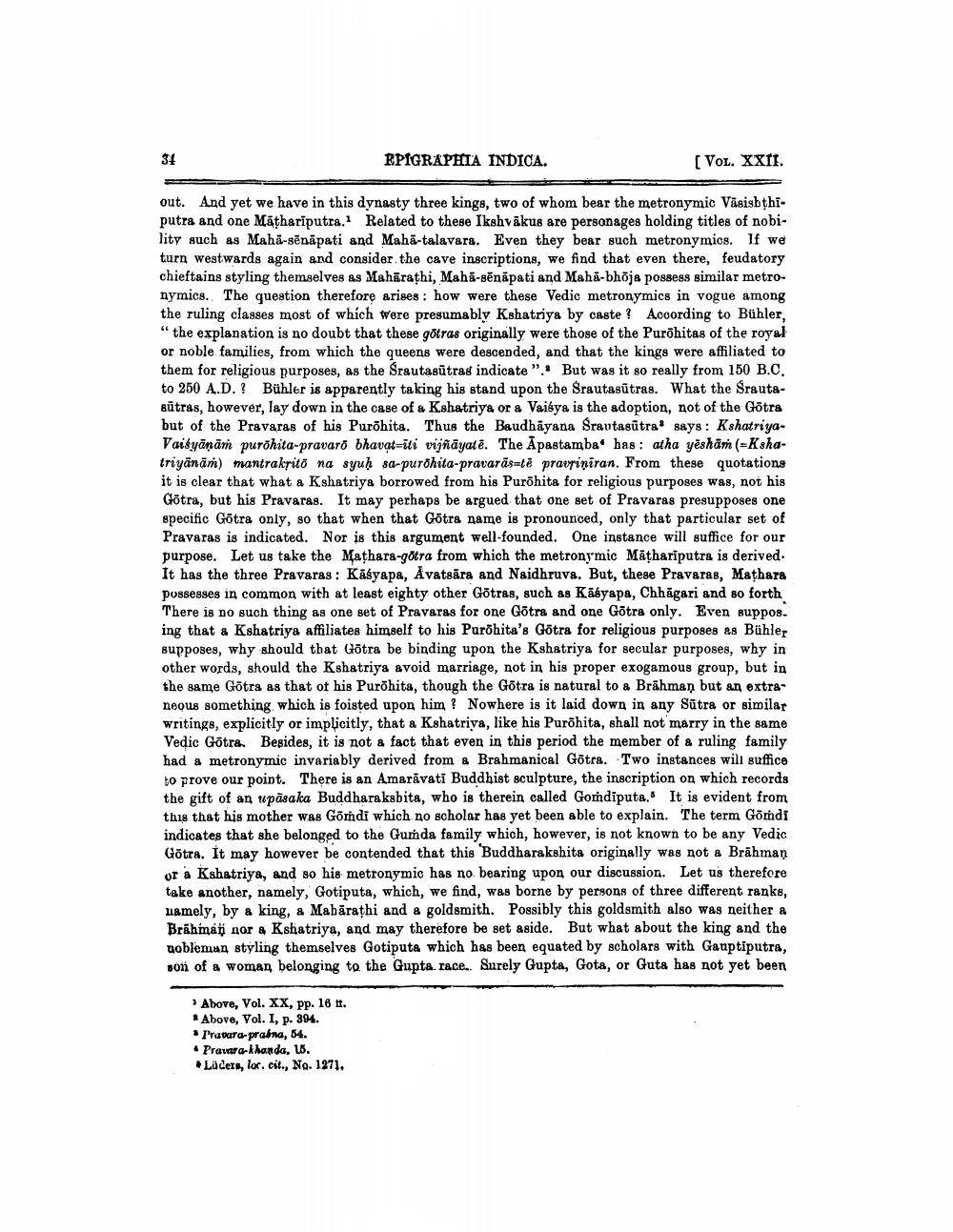________________
EPIGRAPHIA INDICA.
[ VOL. XXII.
out. And yet we have in this dynasty three kings, two of whom bear the metronymic Vāsisbthiputra and one Māthariputra. Related to these Ikshvākus are personages holding titles of nobility such as Mahā-sēnāpati and Mahā-talavara. Even they bear such metronymics. If we turn westwards again and consider the cave inscriptions, we find that even there, feudatory chieftains styling themselves as Mahārathi, Mahā-sēnāpati and Mahā-bhoja possess similar metronymics. The question therefore arises : how were these Vedic metronymics in vogue among the ruling classes most of which were presumably Kshatriya by caste? According to Bühler, "the explanation is no doubt that these gotras originally were those of the Purõhitas of the royal or noble families, from which the queens were descended, and that the kings were affiliated to them for religious purposes, as the Srautasūtras indicate". But was it so really from 150 B.C. to 250 A.D.? Bühler is apparently taking his stand upon the Srautasūtras. What the Srautasūtras, however, lay down in the case of a Kshatriya or a Vaibya is the adoption, not of the Gotra but of the Pravaras of his Purõhita. Thus the Baudhāyana Srautasūtra' says: KshatriyaVaisyānām purõhita-pravaro bhavat=iti vijñāyatē. The Apastambao has: atha yesham (=Kshatriyānāṁ) mantrakrito na syuh sa-purohita-pravarās=tē pravriniran. From these quotations it is clear that what a Kshatriya borrowed from his Purõhita for religious purposes was, not his Götra, but his Pravaras. It may perhaps be argued that one set of Pravaras presupposes one specific Götra only, so that when that Götra name is pronounced, only that particular set of Pravaras is indicated. Nor is this argument well-founded. One instance will suffice for our purpose. Let us take the Mathara-gotra from which the metronymic Mathariputra is derived. It has the three Pravaras: Kaśyapa, Avatsāra and Naidhruva. But, these Pravaras, Mathara possesses in common with at least eighty other Götras, such as Kāsyapa, Chhāgari and so forth There is no such thing as one set of Pravaras for one Gotra and one Gotra only. Even suppos. ing that a Kshatriya affiliates himself to his Purõhita's Gotra for religious purposes as Bühler supposes, why should that Götra be binding upon the Kshatriya for secular purposes, why in other words, should the Kshatriya avoid marriage, not in his proper exogamous group, but in the same Götra as that of his Purõhita, though the Götra is natural to a Brāhman but an extraneous something, which is foisted upon him ? Nowhere is it laid down in any Sūtra or similar writings, explicitly or implicitly, that a Kshatriya, like his Purõhita, shall not marry in the same Vedic Götra. Besides, it is not a fact that even in this period the member of a ruling family had a metronymic invariably derived from & Brahmanical Götra. Two instances will suffice to prove our point. There is an Amarävati Buddhist sculpture, the inscription on which records the gift of an epäsaka Buddharaksbita, who is therein called Gordiputa. It is evident from this that his mother was Göndi which no scholar has yet been able to explain. The term Gömdi indicates that she belonged to the Gumda family which, however, is not known to be any Vedic Götra. It may however be contended that this Buddharakshita originally was not a Brāhman or a Kshatriya, and so his metronymic has no bearing upon our discussion. Let us therefore take another, namely, Gotiputa, which, we find, was borne by persons of three different ranks, lamely, by a king, a Mahārathi and a goldsmith. Possibly this goldsmith also was neither a Brāhmañ gora Kshatriya, and may therefore be set aside. But what about the king and the gobleman styling themselves Gotiputa which has been equated by scholars with Gauptiputra, son of a woman belonging to the Gupta. race. Surely Gupta, Gota, or Guta has not yet been
*Above, Vol. XX, pp. 16 t. * Above, Vol. I, p. 394.
Iravara-prasna, 54. . Pravara-khanda, 15.
Lüders, loc. cit., No. 1271.




